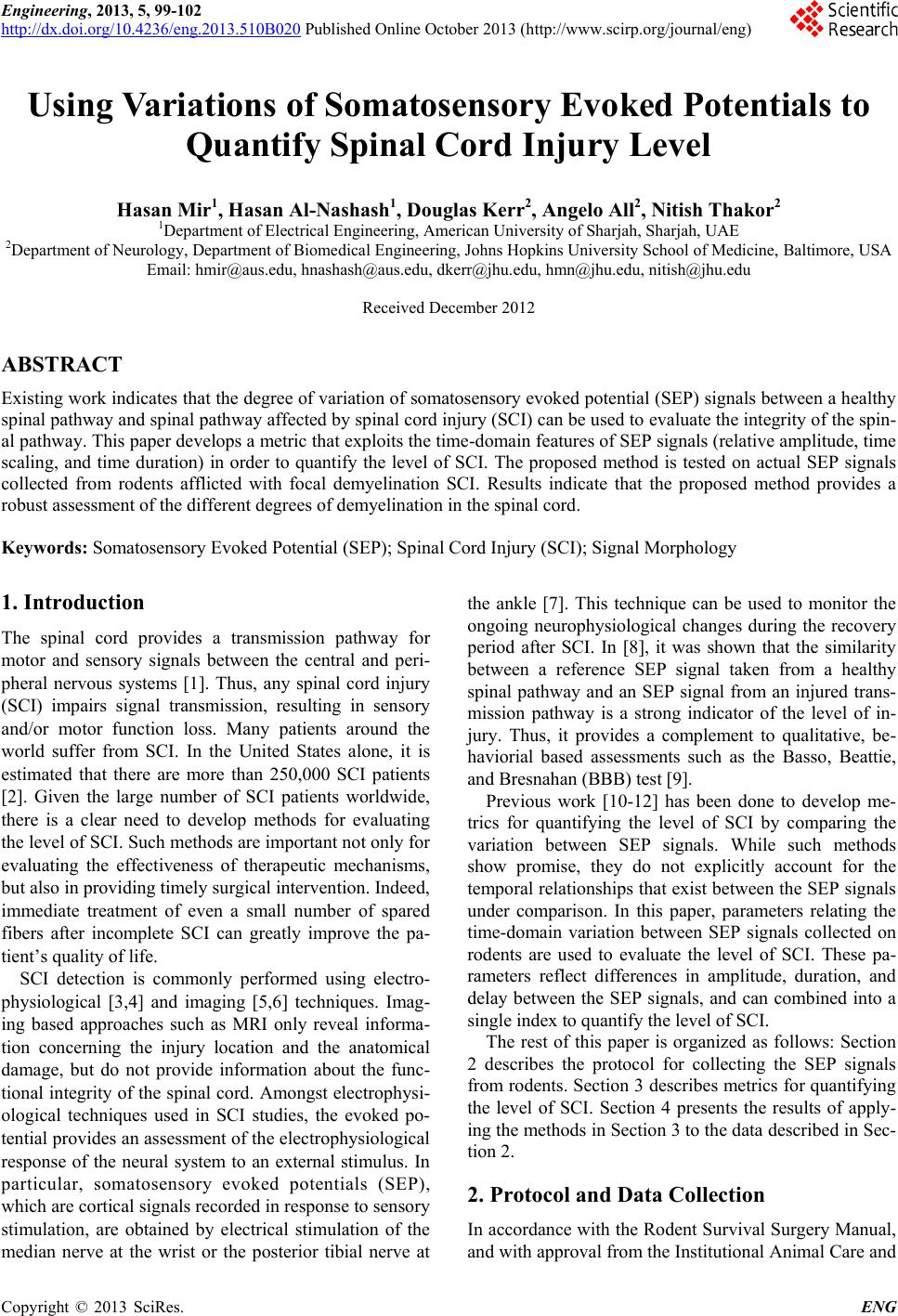
Engineering, 2013, 5, 99-102
http://dx.doi.org/10.4236/eng.2013.510B020 Published Online October 2013 (http://www.scirp.org/journal/eng)
Copyright © 2013 SciRes. ENG
Using Variations of Somatosensory Evoked Potentials to
Quantify Spinal Cord Injury Level
Hasan Mir1, Hasan Al-Nashash1, Douglas Kerr2, Angelo All2, Nitish Thakor2
1Department of E lectrical Engineering, American University of Sharjah, Sharjah, UAE
2Department of Neurology, Department of Biomedical Engineering, Johns Hopkins University School of Medicine, Baltimore, USA
Email: hmir@aus.edu, hnashash@aus.edu, dkerr@jhu.edu, hmn@jhu.edu, nitish@jhu.edu
Received December 2012
ABSTRACT
Existing work indicates that the degree of variation of somatosensory evoked potential (SEP) signals between a healthy
spinal pathway and spinal pathway affected by spinal cord injury (SCI) can be used to evaluate the integrity of the spin-
al pathway. This paper develops a metric that exploits the time-do main features of SEP signals (relative amplitude, time
scaling, and time duration) in order to quantify the level of SCI. The proposed method is tested on actual SEP signals
collected from rodents afflicted with focal demyelination SCI. Results indicate that the proposed method provides a
robust assessment of the different degrees of demyelination in the spinal cord.
Keywords: Somatosensory Evoked Potential (SEP); Spinal Cord Injury (SC I); Signal Morphology
1. Introduction
The spinal cord provides a transmission pathway for
motor and sensory signals between the central and peri-
pheral nervous systems [1]. Thus, any spinal cord injury
(SCI) impairs signal transmission, resulting in sensory
and/or motor function loss. Many patients around the
world suffer from SCI. In the United States alone, it is
estimated that there are more than 250,000 SCI patients
[2]. Given the large number of SCI patients worldwide,
there is a clear need to develop methods for evaluating
the level of SCI. Such methods are important not only for
evaluating the effectiveness of therapeutic mechanisms,
but also in providing timely surg ica l in tervention. Indeed,
immediate treatment of even a small number of spared
fibers after incomplete SCI can greatly improve the pa-
tient’s quality of life.
SCI detection is commonly performed using electro-
physiological [3,4] and imaging [5,6] techniques. Imag-
ing based approaches such as MRI only reveal informa-
tion concerning the injury location and the anatomical
damage, but do not provide information about the func-
tional integrity of the spinal cord. Amongst electrophysi-
ological techniques used in SCI studies, the evoked po-
tential provides an assessment of the electrophysiological
response of the neural system to an external stimulus. In
particular, somatosensory evoked potentials (SEP),
which are cortical signals recorded in response to sensory
stimulation, are obtained by electrical stimulation of the
median nerve at the wrist or the posterior tibial nerve at
the ankle [7]. This technique can be used to monitor the
ongoing neurophysiological changes during the recovery
period after SCI. In [8], it was shown that the similarity
between a reference SEP signal taken from a healthy
spinal pathway and an SEP signal from an injured trans-
mission pathway is a strong indicator of the level of in-
jury. Thus, it provides a complement to qualitative, be-
haviorial based assessments such as the Basso, Beattie,
and Bresnahan (BBB) test [9].
Previous work [10-12] has been done to develop me-
trics for quantifying the level of SCI by comparing the
variation between SEP signals. While such methods
show promise, they do not explicitly account for the
temporal relationships that exist between the SEP signals
under comparison. In this paper, parameters relating the
time -domain variation between SEP signals collected on
rodents are used to evaluate the level of SCI. These pa-
rameters reflect differences in amplitude, duration, and
delay between the SEP signals, and can combined into a
single index to quantify the level of SCI.
The rest of this paper is organized as follows: Section
2 describes the protocol for collecting the SEP signals
from rodents. Section 3 describes metrics for quantifying
the level of SCI. Section 4 presents the results of apply-
ing the methods in Section 3 to the data descr ib ed in S ec-
tion 2.
2. Protocol and Data Collection
In accordance with the Rodent Survival Surgery Manual,
and with approval from the Institutional Animal Care and